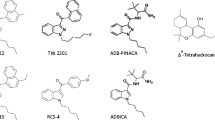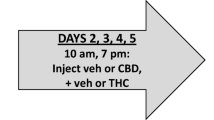Abstract
A low and a high dose of Δ 1-Tetrahydrocannabinol (Δ 1-THC) and of cannabidiol (CBD) were IP injected in rats that had been isolated for 7 days. Forty-five minutes after injection, the rats were tested for social interactions with non-isolated, untreated test partners in dyadic encounters under standardized conditions. Different aspects of social behavior were analyzed. The high dose of Δ 1-THC (10 mg/kg) prevented nearly all social interactions. The low dose of Δ 1-THC (1 mg/kg) exerted selective and specific effects on social interactions. Social contact behavior, including crawl over/mounting, and social grooming, and aggressive behavior, including fighting, kicking, and biting, were markedly decreased, whereas social exploratory behavior (exploration of the partner and anogeniaal investigation) and the behavioral item, approach/follow, were hardly affected by Δ 1-THC treatment. Both doses of CBD (2 and 20 mg/kg) failed to change the various aspects of social interaction. It is postulated that the effects of Δ 1-THC on close and intimate contact behavior of rats may contribute to the understanding of marihuana taking in humans.
Similar content being viewed by others
References
Alves CN, Goyos AC, Carlini EA (1973) Aggressiveness induced by marihuana and other psychotropic drugs in REM sleep deprived rats. Pharmacol Biochem Behav 1:183–189
Carlini EA (1977) Further studies of the aggressive behavior induced by Δ 9-tetrahydrocannabinol in REM sleep-deprived rats. Psychopharmacology 53:135–145
Cutler MG, Mackintosh JH (1975) Effects of delta-9-tetrahydrocannabinol on social behaviour in the laboratory mouse and rat. Psychopharmacologia 44:287–289
Dorr M, Steinberg H (1976) Effects of Δ 9-tetrahydrocannabinol on social behaviour of mice. Comparison between two vehicles. Psychopharmacology 47:87–91
Fujiwara M, Ueki S (1979) The course of aggressive behavior induced by a single injection of Δ 9-tetrahydrocannabinol and its characteristics. Physiol Behav 22:535–539
Gaoni Y, Mechoulam R (1971) The isolation and structure of Δ 1-THC and other Cannabinoids of Hashish. J Am Chem Soc 93:217–224
Kilbey MM, Fritchie GE, McLendon DM, Johnson KM (1972) Attack behaviour in mice inhibited by Δ 9-tetrahydrocannabinol. Nature 238:463–465
McGuire MT, Raleigh MJ, Brammer GL (1982) Sociopharmacology. Ann Rev Pharmacol Toxicol 22:643–661
Miczek KA (1978) 564-6: antiaggressive effects in mice, rats and squirrel monkeys. Science 199:1459–1461
Niesink RJM, Van Ree JM (1982a) Short-term isolation increases social interactions of male rats: a parametric analysis. Physiol Behav 29:819–825
Niesink RJM, Van Ree JM (1982b) Antidepressant drugs normalize the increased social behaviour of pairs of male rats induced by short term isolation. Neuropharmacology 21:1343–1348
Niesink RJM, Van Ree JM (1983) Changes in social behaviour of rats following chronic treatment with γ-endorphin antiserum injected into the nucleus accumbens. Neuropharmacology 22:819–826
Nir I, Veldhuis HD, Van Ree JM (1984) 565-1 circling behavior in rats: A possible measure of psychotomimetic activity? Psychopharmacology 84:556–560
Santos M, Sampaio MRP, Fernandes NS and Carlini EA (1966) Effects of Cannabis sativa (marihuana) on fighting behaviour of mice. Psychopharmacologia 8:437–444
Shapiro SS, Wilk MB (1965) An analysis of variance test for normality (complete samples). Biometrika 52:591–611
Sieber B, Frischknecht HR, Waser PG (1980) Behavioral effects of hashish in mice. I. Social interactions and nest-building behavior of males. Psychopharmacology 70:149–154
Ten Ham M, Van Noordwijk J (1973) Lack of tolerance to the effects of two tetrahydrocannabinols on aggressiveness. Psychopharmacologia 29:171–176
Van Ree JM, Slangen JL, De Wied D (1978) Intravenous self-administration of drugs in rats. J Pharmacol Exp Ther 204:547–557
Author information
Authors and Affiliations
Rights and permissions
About this article
Cite this article
van Ree, J.M., Niesink, R.J.M. & Nir, I. Δ 1-tetrahydrocannabinol but not cannabidiol reduces contact and aggressive behavior of rats tested in dyadic encounters. Psychopharmacology 84, 561–565 (1984). https://doi.org/10.1007/BF00431467
Received:
Accepted:
Issue Date:
DOI: https://doi.org/10.1007/BF00431467




